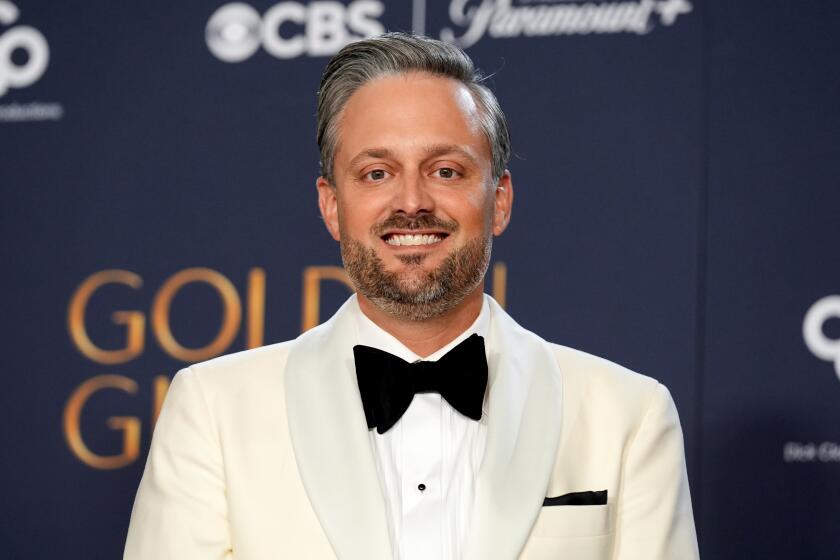Producer Bucks Trend Toward Fast-Pace Shows : Television: KCET’s Nancy Salter favors a personal, intimate approach to documentaries. Her latest, ‘Living the Last Days,’ took nine months to make.
- Share via
Think of Nancy Salter’s work as the opposite of “48 Hours.”
Salter, 44, has been producing documentaries for Los Angeles public-TV station KCET for 20 years--at her own distinct pace. While CBS’ “48 Hours” careens through a news story in just two days, Salter’s probing one-hour documentaries might take as many as 26,280 hours (that’s three years, and not such a catchy title)--though the average production time is closer to nine months.
Salter’s programs, which have netted seven local Emmys, shun the hard-hitting investigative approach of a “48 Hours” or a “60 Minutes”--as well as the high drama of today’s new crop of “reality” shows, such as “Unsolved Mysteries” and “America’s Most Wanted.” She favors a highly personal, intimate style of documentary making.
Achieving that level of intimacy, Salter says, takes lots of time and plenty of videotape.
Salter spent three years following several infertile couples determined to conceive a child for a 1988 documentary called “Expecting Miracles.” In 1983, she spent months gaining the trust of several Los Angeles-area families who eventually talked freely to her camera about family violence and incest in “Generations of Violence.”
Salter’s newest documentary, “Living the Last Days,” which airs at 8 p.m. Wednesday on Channel 28, focuses on another touching local story--that of Brownlie Hospice, located near Elysian Park, one of the first hospices for people dying of complications from AIDS. It was nine months in the making.
Stephen Kulczycki, KCET’s senior vice president and station manager, acknowledges that Salter’s approach is expensive. She shoots an average of 60 hours of tape per documentary. Not only does it take time to shoot the material--it can take as long or even longer to edit it down to an hour.
Kulczycki believes the extra time and money are worth it, however.
“Nancy’s got a gift for making powerful documentaries about how people live and the choices they make,” he says.
“We think it’s important to apply resources to opening up some large questions, and looking at the human effects and implications,” Kulczycki continues. “Nancy’s gift is that she is able to get people to talk to her.”
Salter says she has stayed at KCET all these years both because the station tolerates her pace and to avoid the cruel world of fund-raising, the bane of independent documentary makers.
“This is the style that I like to do things in; it’s just kind of worked out for me to do it here,” she says simply. “It’s not as though anyone has ever said, ‘We like how long it takes this woman to do these programs.’ ”
An unassuming woman who seems virtually untouched by pop culture, Salter pays little attention to network documentaries (the only network show she says she watches regularly is CBS’ “Falcon Crest”). Despite her bevy of Emmys, she says she has had no offers to work on network news shows or reality shows. Nor, she supposes, would she want to.
“In all that ‘reality’ stuff now, people are staging a lot of it, all the re-enactments,” she says. “I really like to get the actual thing happening. What I like is when we’re there and the camera is actually rolling and something wonderful happens.”
By “wonderful,” Salter means “real”--something unfolding on camera, rather than being described by a talking head. A scene from “Living the Last Days,” for example, casts an unexpected light on a resident’s death: The patient wants to die; staff members surround his bed, holding his hand, assuring him that death will come soon. The end of his life becomes bittersweet rather than merely tragic.
Salter has also grown weary of the investigative style. “When you’re working on news and public-affairs kinds of series, it’s very much designed by a committee of people. They’re still, in a way, fitting into a formula. As time goes on, the stories tend to repeat themselves.”
Salter tries to avoid tension between herself and her subjects by staying off-camera, often avoiding the use of a narrator to allow those involved to tell their own stories. Still, sometimes her subjects insist on creating friction. When producing “Expecting Miracles,” for example, some of her subjects resented the fact that Salter has children. At Brownlie Hospice, one staff member at first told her she had no right to try to capture the feelings of the residents because Salter was not herself HIV positive.
Despite such concerns, Salter says that no one, including the terminally ill residents at Brownlie, has ever asked her to turn off the camera once they had agreed to participate.
More to Read
The complete guide to home viewing
Get Screen Gab for everything about the TV shows and streaming movies everyone’s talking about.
You may occasionally receive promotional content from the Los Angeles Times.






